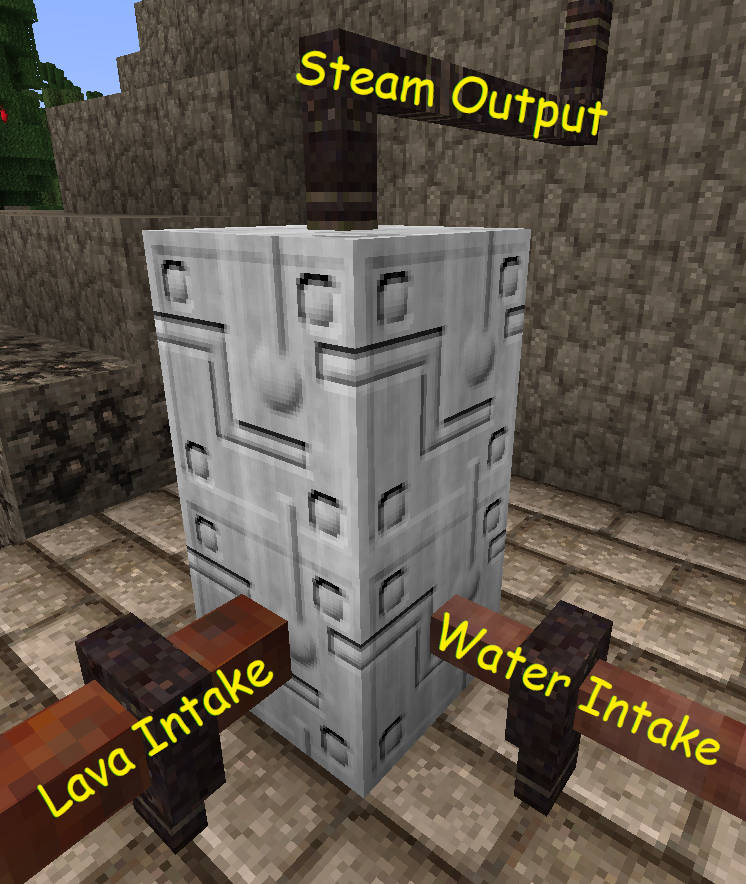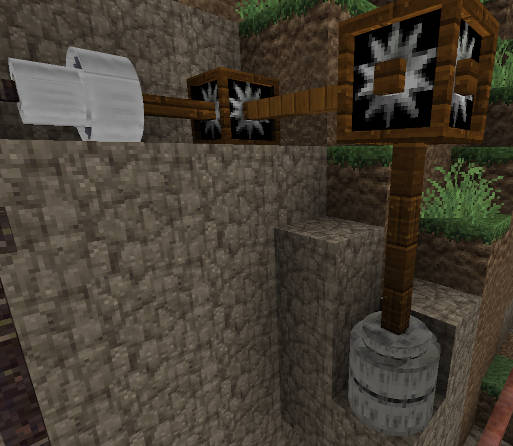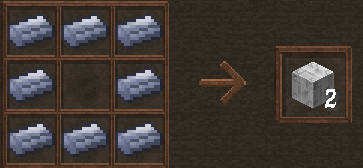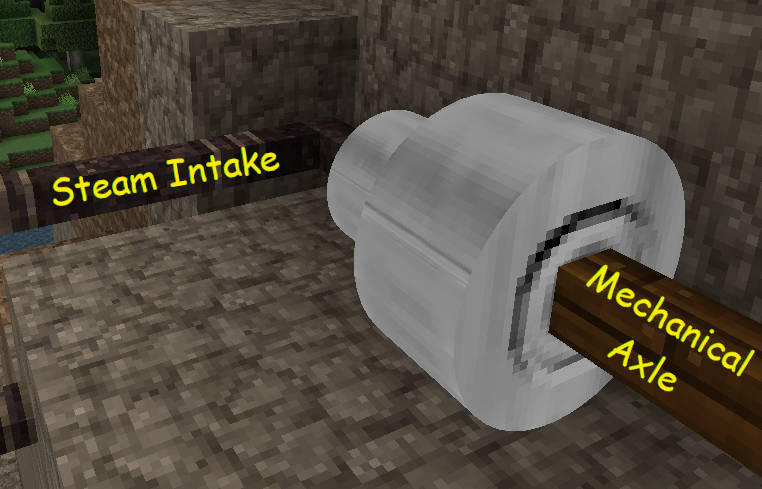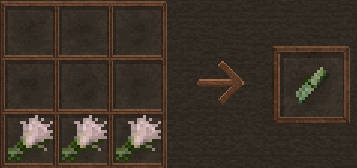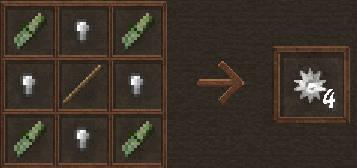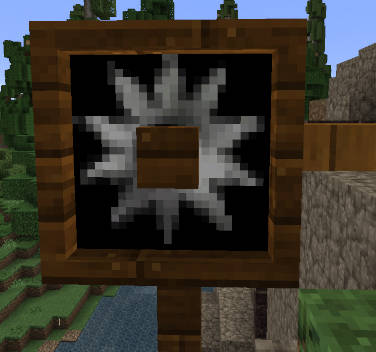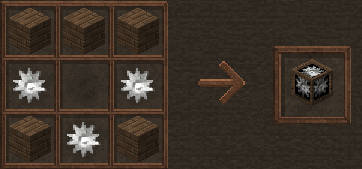Quern Automation (Millstone)
In this tutorial we introduce the boiler and the steam turbine to automate your quern into what is more commonly known as a millstone. This is a big step in terms of tutorials, we will be introducing more than a few new machines and concepts, this is necessary to get something working:
- Boiler
- Steam
- Iron piping system
- Steam turbine
- Wooden axle system
This tutorial assumes that you have completed the How to make a Quern / Millstone, Make a Cooking Cauldron, Refractory Furnace, and Auto-hydrating Cooking Cauldron tutorials. If you haven't completed all of those tutorials then some steps in this tutorial may be confusing.
Before you Begin
There are some prerequisites that are not covered by the tutorials that are necessary to complete this tutorial.
Flax
Make sure you have a fully-operational flax farm running. You are going to need a lot of flax to make the various machine components.
Molybdenum
You'll need a fair bit of molybdenum for this tutorial, 16 ingots in total. But this shouldn't be an issue for you, you should already have some from completing the refractory furnace tutorial.
Location! Location! Location!
It is very important that you pick a prime location for the following key things:
- Boiler
- Machine shop
Boiler Placement
The boiler is a multi-block structure. All it takes for a boiler to operate is one boiler block, in this example we illustrate two boiler blocks stacked vertically, but you could have hundreds of adjacently-connected boiler blocks arranged in any shape you like (for an example, see the boiler in the Royal Castle on the J+K Lands Whitelist Server). The key is to have enough room for the pipes.
The way the boiler works is that it takes lava from one source, water from another source, and then produces steam out the top (depicted above). Since you've already completed other tutorials explaining how the water and lava piping system works, we can move-on to the boiler and the steam piping system. We use iron pipes to transport the steam the boiler produces to a steam turbine that transforms the steam into mechanical power.
It is important to choose the right location for your boiler, it should:
- ...be somewhere below a nearby water source
- ...be near a source of lava (preferably not too far above it)
- ...be somewhere where you have enough room nearby to build a machine shop that you can get to easily
Power Changes over Distance
If you transport any liquid or steam over long distances there are important ramifications to be aware of:
- Steam increases power the higher it goes upward (decreases going downward)
- Both water and lava increase power the lower they are moved downward (decreases going upward)
If you have insufficient power then your machines will not work. If you have too much power then your pipes will start to explode, which can spread fires and knock-out nearby structures (incidentally, there is a way to mitigate pipes bursting using iron pipe stands / braces, we will discuss this in another tutorial though).
Quern Placement
Since the quern is connected to axles from above, you will be placing your quern below the steam turbine, or at least in a way that makes it convenient for you to build your axle network above it.
Words of Caution
Now that you're thoroughly terrified of this thing let's terrify you some more, always make sure your water and lava sources are off or disabled while you're working with them. If you work with water piping that is coming from a live water source then water will spill out of your pipes potentially damaging structures and even destroying sources of lava. If you work with lava piping that is coming from powered thermal accelerators then you will spread lava everywhere starting fires and even catching yourself on-fire.
There is also some additional wisdom to ensuring that your water and lava sources are powered-off and disabled while working with a boiler, if you remove a boiler block while it is connected to any live source of water or lava you will create a very large explosion and lose all of your boiler blocks along with anything else in the vicinity. While I was working on this tutorial I accidentally hit a boiler and blew it up. This caused the exposed pipes to mix water and lava creating obsidian and thus creating blockage at the lava pipe, which in turn caused the thermal accelerator to overload and explode as well. So the wisdom here is never remove a boiler that is under pressure.
Let's Start Building
Boiler
The boiler is simple to build, it's like building a regular furnace but with molybdenum ingots. You more than likely have some left-over from crafting your first thermal accelerator. Each set of 8 molybdenum ingots will produce two boiler blocks.
Like the thermal accelerator, the boiler must be placed on a stable foundation. Leave enough room to connect copper and bauxite pipes at the bottom to transport water and lava (respectively) into it.
Steam Turbine
The steam turbine takes steam input and produces mechanical power output via wooden axles. This is also a multi-block structure, and you have the option of placing one steam turbine block (low-pressure and low-power) or two steam turbine blocks adjacent to each other (high-pressure and maximum power). In this example we will only demonstrate the low-pressure variant (one turbine block).
NOTE: If you want to build a high-pressure variant then simply place another turbine block at the back of the first turbine block (at the narrow end), which might mean you'll have to remove at least one iron steam pipe to make room for it.
Crafting Recipes
The turbine is a little more complicated than the boiler, it involves one additional ingredient called a gear, which requires flax bundles to craft, which are crafted from the harvested flax plant.
Flax Bundles
First lets craft a lot of flax bundles, you're going to need these for the wooden axle system as well, so make a lot.
Gear
Now let's craft at least one gear so we can craft our steam turbine, you will need one stick, 4 iron nuggets (to craft an iron nugget just put an iron ingot in your crafting matrix, you'll get 9 nuggets for every ingot), and 4 flax bundles to produce 4 gears.
Turbine
Finally we are ready to craft the turbine, just like the boiler, arrange 8 molybdenum ingots in your crafting matrix and place the gear in the centre.
Iron Pipes
In order to move steam from the boiler to the turbine we need to craft and place iron pipes connecting them. Since you're already familiar with crafting copper pipes, do the same thing to connect the top of your boiler to the narrow end of your turbine using iron pipes crafted from iron ingots. Iron pipes are just like copper pipes in every way except that they are stronger and capable of transporting steam and are made from iron instead of copper.
Lava and Water Sources
This step should be easy for you if you've completed the other tutorials, connect your thermal accelerator and water intake funnel (via bauxite and copper piping respectively) to the bottom of your boiler assembly (it doesn't have to be the bottom block, you could connect it to the top block, but you'll get slightly more power if it's connected at the bottom). Refer to the illustration at the beginning of this tutorial here for reference.
Mechanical Axles
Now we introduce the fun and exciting new element to all of this: wooden axles for mechanical power. Wooden axles are similar to pipes but they have a few differences:
- They transport invisible mechanical power instead of some fluid or steam
- There are no corner, T-Section or 3-Way axles, instead there is a one-size-fits-all gear box.
- The crafting recipes are very different
Gear Boxes
Gear boxes allow you to change axle direction or split mechanical power into two or more axles. One major downside of using these is that they attenuate / reduce available mechanical power, so it is best to place as few of these as possible. One strategy I have opted for is to make sure my steam turbines are close-by and rely on zig-zagging steam through the world instead of mechanical power.
Crafting
Crafting a gear box requires gears and wooden planks. It can be crafted from any of the major wooden planks (e.g. birch, oak, jungle etc.). Build as many of these as you need, although for this tutorial you shouldn't need more than a few.
Axles
Axles work a lot like pipes, they connect to various machines that work via mechanical power and they connect to gear boxes to change direction or split power into multiple axle lines. Moreover, you can still use a pipe wrench to rotate them even though they aren't technically pipes.
To craft a wooden axle you will need some wood as well as more flax bundles, make sure you craft a lot of these, you might need at least 10 for this tutorial.
Attach your Quern
Now comes the finishing touch, your quern becomes a mechanical millstone when it is attached to wooden axles providing mechanical power. Remove the lever on-top of your quern and place axles on it instead connecting it to the front of your steam turbine (the broad end). Use gear boxes (like corner pipes) to change axle direction as needed.
Using Your Millstone
Now that you have a mechanically powered millstone (instead of a quern) you no longer have to starve to death from pulling a lever ad nauseum just to make some flour from wheat so you can bake bread and prevent yourself from starving to death. Just put your wheat, netherrack, iron ore, or bones (whatever you want to grind into dust) and then turn on the power!
Controlling Power
There several different ways to control the power of your millstone (or anything connected via steam power for that matter), some of which involve advanced concepts reserved for a future tutorial. One key thing to keep in-mind about a boiler is that if it doesn't have a balanced mixture of both water and lava it will produce no steam and thus will not power any connected turbines and those in-turn will not power any connected machines. So one logical and simple way to control power of your machine shop is to cut either the lava or the water sources (or both if you're absolutely thorough):
- Changing piping network for steam via valves to some other piping network
- Vent steam into outer space (just kidding, there is no outer space in Minecraft, but you can vent it into the air)
- Cutting power to thermal accelerators
- Using a sticky piston to move a block over-top of a water intake funnel effectively blocking water from entering it
- Vent the lava using a valve
- Vent the water using a valve
- Using a junction box (wooden mechanical axle system) to cut power to the axles
- Using sticky pistons to physically displace the pipes (not recommended for steam, there's a chance the venting steam will burn-up the pipe that was just displaced, and I'm not sure if this is a bug or a feature).
Congratulations! You're a Dwarf Now!
If you've made it this far through the tutorial you've earned the right and the privilege of being named dwarf among your people, a prestigious title given to clever engineers and craftsmen. If you're on the J+K Lands Whitelist Server contact Vonkepps and he'll award you a special magical pipe-wrench. In future tutorials we'll show you how to connect-up multiple machines and expand your pipe network to have more power.
Attachments (13)
-
axle-recipe.jpeg
(19.0 KB
) - added by 5 years ago.
Wooden mechanical axle crafting recipe
-
boiler-recipe.jpeg
(21.6 KB
) - added by 5 years ago.
Boiler crafting recipe
-
boiler-to-turbine-piping.jpeg
(25.3 KB
) - added by 5 years ago.
Connecting the boiler to the turbine
-
boiler.jpeg
(123.4 KB
) - added by 5 years ago.
The steam boiler
-
flax-recipe.jpeg
(18.9 KB
) - added by 5 years ago.
Flax bundle recipe
-
gear-recipe.jpeg
(20.0 KB
) - added by 5 years ago.
Mechanical gear recipe
-
gearbox-recipe.jpeg
(20.2 KB
) - added by 5 years ago.
Mechanical gear-box recipe
-
gearbox.jpeg
(33.8 KB
) - added by 5 years ago.
Mechanical gear-box
-
quern-placement.jpeg
(49.6 KB
) - added by 5 years ago.
Placing the quern effectively
-
turbine-recipe.jpeg
(21.5 KB
) - added by 5 years ago.
Steam turbine recipe
-
turbine.jpeg
(61.2 KB
) - added by 5 years ago.
The steam turbine
-
flax-farm.jpeg
(70.3 KB
) - added by 5 years ago.
A field of flax
-
boiler-assembly.jpeg
(205.1 KB
) - added by 5 years ago.
Steam engine assembly
Download all attachments as: .zip



